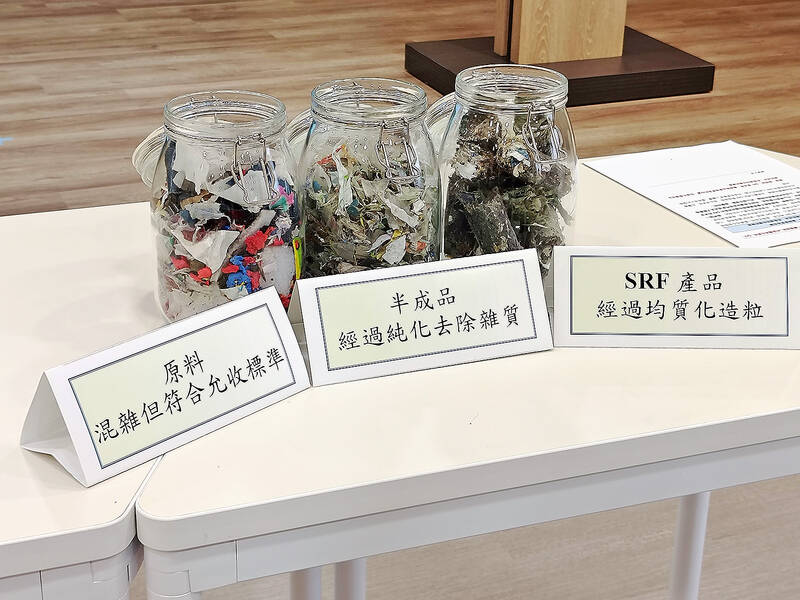The Ministry of Environment plans to propose stricter regulations on heavy metals and dioxins related to solid recovered fuel (SRF) by the end of the year, it said on Friday after releasing a report on the results of its nationwide inspection of 48 manufacturers and 18 users of SRFs.
SRFs are made from nonhazardous waste from businesses that can be burned as fuel, Minister of Environment Peng Chi-ming (彭啟明) said, adding that quality SRFs can only be produced through purification and homogenization.
The ministry would propose new SRF regulations by the end of the year to establish a third-party certification system, install closed-circuit television systems to monitor the areas where materials are collected and impose stricter standards on the emission of harmful substances such as dioxins, Resource Circulation Administration Director-General Lai Ying-ying (賴瑩瑩) said.

Photo: Wu Po-hsuan, Taipei Times
Under the stricter regulations, companies in the industry would have to make more effort and invest more to improve their products and processes, Peng said, adding that “this is not to increase the companies’ costs, but to increase Taiwan’s assets.”
SRF production volume has increased from 50,000 tonnes in 2019 to 290,000 tonnes last year, and most manufacturers were small and medium-sized businesses, Lai said, citing the report.
Although one manufacturer did not install an essential device for purification and homogenization of SRF, all manufacturers’ SRF products met quality standards, she said, adding that SRF combustion efficiency could be improved.
Eighteen manufacturers did not report where their products were sold, although it was required by law, and one manufacturer has never reported the destinations of its products, she said.
While 29 manufacturers sold SRF products directly to users in accordance with regulations, 11 did not and eight had yet to sell their products, she added.
Most SRF users were factories of large companies in the paper, cement and power supply industries, which mainly used coal, Lai said.
Although SRF-users’ sulfur oxides and nitrogen oxide emissions met regulations, 25 percent of the users fell short of the emission standards for dioxins, she said.
Overall, 52 to 70 percent of SRF manufacturers met standards and 30 to 48 percent needed improvements, while more than 90 percent of SRF users met standards and 6 percent should improve, she said.
Meanwhile, 14 SRF producers said they would leave the market after the inspection, while two manufacturers said they would stop production as SRF was not their main product, Lai said.
Two users said they would use other fuels instead of SRFs, she said.
Ten manufacturers said they would transition from the market as their waste had simple properties and as they had matured their waste reuse technology, she said.
About 6.5 million tonnes of waste is sent to incinerators every year, 1.8 million tonnes of which is business waste, Deputy Minister of Environment Shen Chih-hsiu (沈志修) said.
If business waste could be recycled using SRF production technology, incinerator capacity could be freed for burning noncommercial waste, which would reduce “waste mountains” in Taiwan, he said.

SHIPS, TRAINS AND AUTOMOBILES: The ministry has announced changes to varied transportation industries taking effect soon, with a number of effects for passengers Beginning next month, the post office is canceling signature upon delivery and written inquiry services for international registered small packets in accordance with the new policy of the Universal Postal Union, the Ministry of Transportation and Communications said yesterday. The new policy does not apply to packets that are to be delivered to China, the ministry said. Senders of international registered small packets would receive a NT$10 rebate on postage if the packets are sent from Jan. 1 to March 31, it added. The ministry said that three other policies are also scheduled to take effect next month. International cruise ship operators

NUMBERS IMBALANCE: More than 4 million Taiwanese have visited China this year, while only about half a million Chinese have visited here Beijing has yet to respond to Taiwan’s requests for negotiation over matters related to the recovery of cross-strait tourism, the Tourism Administration said yesterday. Taiwan’s tourism authority issued the statement after Chinese-language daily the China Times reported yesterday that the government’s policy of banning group tours to China does not stop Taiwanese from visiting the country. As of October, more than 4.2 million had traveled to China this year, exceeding last year. Beijing estimated the number of Taiwanese tourists in China could reach 4.5 million this year. By contrast, only 500,000 Chinese tourists are expected in Taiwan, the report said. The report

The Forestry and Nature Conservation Agency yesterday launched a gift box to market honey “certified by a Formosan black bear” in appreciation of a beekeeper’s amicable interaction with a honey-thieving bear. Beekeeper Chih Ming-chen (池明鎮) in January inspected his bee farm in Hualien County’s Jhuosi Township (卓溪) and found that more than 20 beehives had been destroyed and many hives were eaten, with bear droppings and paw prints near the destroyed hives, the agency said. Chih returned to the farm to move the remaining beehives away that evening when he encountered a Formosan black bear only 20m away, the agency said. The bear

Chinese embassy staffers attempted to interrupt an award ceremony of an international tea competition in France when the organizer introduced Taiwan and displayed the Republic of China flag, a Taiwanese tea farmer said in an interview published today. Hsieh Chung-lin (謝忠霖), chief executive of Juxin Tea Factory from Taichung's Lishan (梨山) area, on Dec. 2 attended the Teas of the World International Contest held at the Peruvian embassy in Paris. Hsieh was awarded a special prize for his Huagang Snow Source Tea by the nonprofit Agency for the Valorization of Agricultural Products (AVPA). During the ceremony, two Chinese embassy staffers in attendance